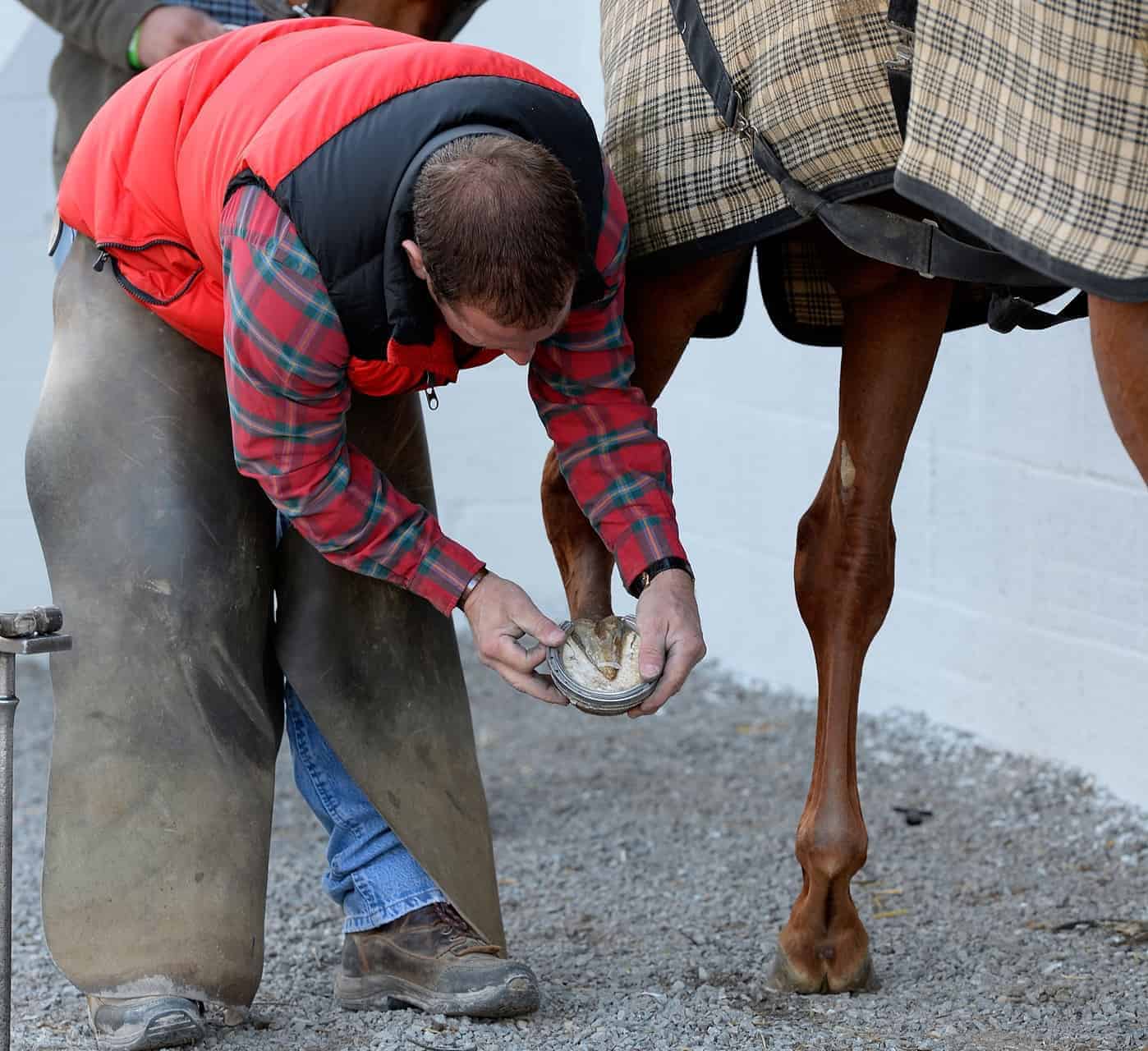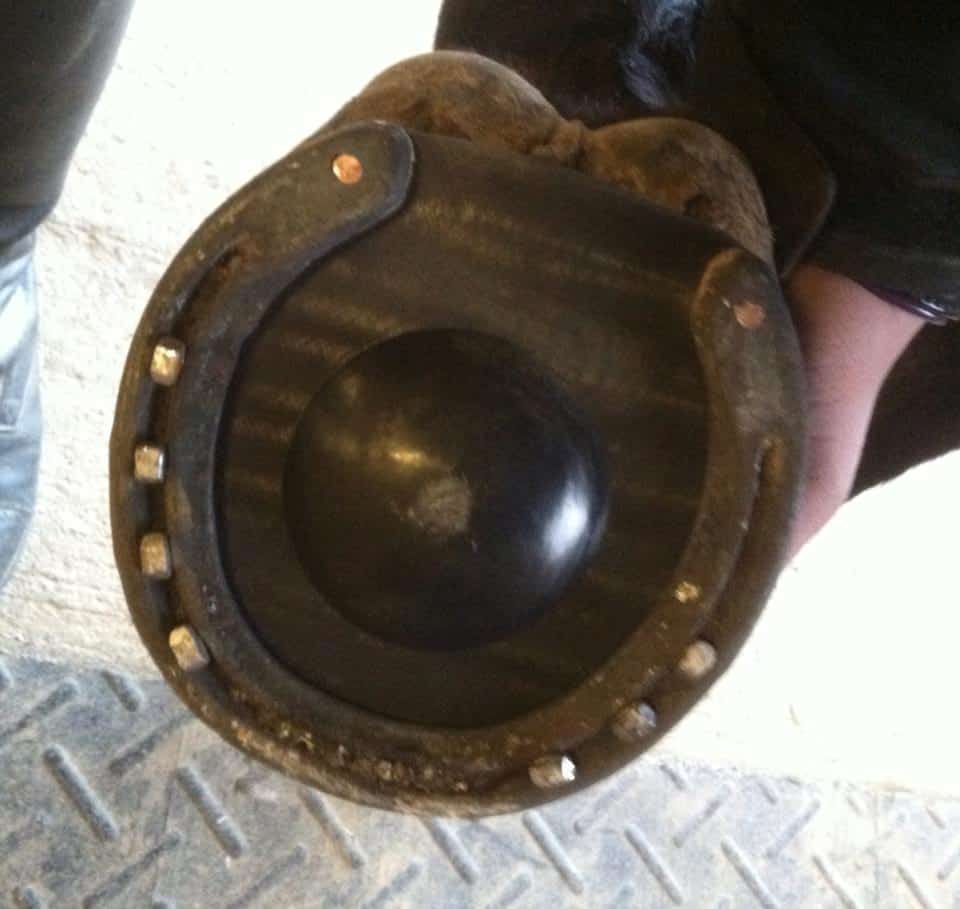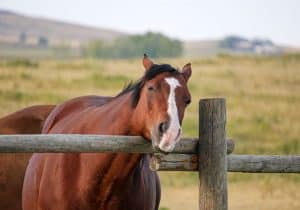Winter Horse Hoof Care: It’s a Team Effort
- Topics: Article, Farrier Issues, Hoof Care, Horse Care, Lameness, Shoeing, Sports Medicine, Winter Care

Keep your horse sound and moving safely this winter with these smart hoof care practices
Perched on the edge of the North Ranger Trail, a steep, rocky upward slog in the middle of Montana’s Crazy Mountains, I twisted around in my saddle to look backward. The 10-year-old rider—a good little horsewoman, but new to Montana’s rocky trails—sat petrified on her horse’s back about 20 feet behind me, staring up the narrow path between my horse and hers. I knew her horse, Oreo, a Rocky Mountain homebred who had grown up here, would power over the rocks without hesitation; the real problem here was motivation.
“Give him a squeeze,” I called back encouragingly, as Oreo dropped his head and started to crop at the timothy. “Or,”—getting an idea—“drop him into four-wheel-drive! Oreo’s got four legs—ask him to use them all!”
Looking up and giggling, she gave Oreo a massive squeeze, and up he went, handily picking his way through the rocks, timothy stalk still poking out of the corner of his mouth. Disaster averted.
On a clear summer’s day with a dry trail and a horse bred to tackle it, it’s easy to ask our horses to simply drop it in “four-low” and move. But once this same trail ices over in the winter, I wouldn’t dream of it.
Using common sense when deciding what your horse can and can’t do during the wintertime is key. But your farrier and your veterinarian can also play a huge role in how—or if—you outfit your horse with a set of winter treads. These individuals are your first line of defense in keeping your horse’s hooves healthy and strong year-round.
First, Know Yourself and Your Horse
Horses have evolved to be pretty self-sufficient in cold winter climates. If left to their own devices, most horses will naturally develop hard hooves that, when left barefoot, provide adequate protection from most of what winter throws at them. Things get trickier when we start asking them to do activities beyond eating, drinking, and sleeping—for example, going for a trail ride, or walking the same damp path between barn and pasture until it’s a treacherous, icy mess.
“It all goes back to the use of the horse over the winter,” says Patrick Hall, CJF, APF, a Fort Collins, Colorado-based American Farrier’s Association Certified Journeyman Farrier. “One of the most important things you can do is talk with your farrier about how much riding you do through the winter and what kind. Your horse’s needs will be very different if he’s being used primarily for dressage in an arena or being asked to pull a carriage on slippery roads.”
Questions to ask yourself include how much and what kind of riding you’ll be doing and how frequently you’ll be doing it. And be honest—maybe it’s a beautiful, sunny fall day when your farrier comes to visit, but will you really be riding five days a week when there’s a foot of snow outside? Also, consider your environment. If you live in the aptly named Rocky Mountains, you might consider multipurpose pads to protect soles from rocks. If you live in Virginia, you might factor hock-deep mud into the equation. In Vermont, where AFA Certified Farrier Jennifer Poulin, APF, runs her business, mud and manure cause their own unique challenges by freezing into hard ridges that Poulin has jokingly dubbed “poopsicles.”
Gain Traction (If You Need It)
For many horse owners, the first snowfall prompts a call to the farrier and a request to pull all four shoes for the winter. Going barefoot provides better traction than standard shoes, which makes it a great option for horse owners who don’t plan to ride much while there’s ice or snow on the ground.
If you do plan to ride throughout the winter, you might be tempted to ask your farrier to give your horse traction for the entire season—just in case—with the mindset that prevention is the best cure. But in this case the tenet is not necessarily true, says Poulin.
“If your horse has too much traction, his natural flight pattern is stunted,” she says. “His hoof will hit the ground and stop abruptly, creating added concussion and inhibiting his natural stride.”
Hall agrees, noting that various methods of adding traction, such as welding borium (a metal alloy) to the shoe, or using studs in shoes, can also put strain on hocks and stifles—not to mention the horse and human safety risk pointy metal spikes welded or screwed into your horse’s shoes can pose.
That said, there are situations where adding traction can be the difference between safe, enjoyable year-round riding and a four-month off-season. In Western Pennsylvania where I grew up, the roads are pockmarked with deep trenches from the borium on the hooves of the horses used to pull Amish buggies—a testament (and a warning) to how much traction borium can provide. The same goes for permanent drive-in studs applied to carriage horses’ shoes.
But it’s also possible to get studs that provide no more than a small nubbin of traction that will help your horse keep his feet without hindering his stride. Borium-tipped horseshoe nails, also known as “ice nails,” are another option. And if you’re a rider who needs only occasional traction for Saturday trail rides, you might consider screw-in studs. Just know that you’ll need to allow enough thaw time for the ice buildup in the hole used to secure the screw, warns Hall. That means being strategic about how early you bring your horse in from the pasture before a ride.
Consider Snowpack
There’s nothing worse than looking out into your snow-covered pasture to see your horse standing very, very still … and looking three inches taller than usual.
“Your best defense against snowballs is to always carry a good hoof pick,” Hall says. “Spraying cooking oil on the foot can help until it wears off, but nothing’s better than a good old-fashioned hoof pick.”
Trimming your horse’s hooves regularly will also help, adds Poulin. “Too much length can actually make your horse more susceptible to built-up snowballs. Hoof growth slows in the wintertime, but it’s still important to keep horses on a regular trim schedule.”

Many farriers turn to special snow pads to keep snow from building up inside hooves. “Bubble” or “pop” pads fully cover the foot and have an air-filled bubble in the center. When snow packs into the foot, the air bubble literally pops the snow out, preventing buildup. The other common option is a rim pad, which has a thin tube that runs along the inside edge of the shoe. Rim shoes leave the frog exposed, making them a good option for horses in wetter climates.
“Since the center is open, it drains a little bit better, which can be good for environments where you’re dealing with thrush,” notes Hall. “However, sometimes it doesn’t keep out the snow as well as the poppers, and it won’t protect against rocks. Ultimately, it all comes down to owner preference.”
Winter-Proof Your Pastures and Barn
The name “poopsicles” might make you smile, but the damage caused by frozen manure or mud isn’t very funny.
“Mud—and particularly frozen mud—is a real hazard,” notes Rick Tully, DVM, of Elkhorn Veterinary Clinic, in Elkhorn, Wisconsin. “When we have a wet, muddy fall here in Wisconsin, and then it freezes solid, you end up with frozen, uneven ruts that last all winter long. That can create major orthopedic issues that last into the spring and summer.”
While you can’t control the rain, mucking out regularly can help prevent the dreaded poopsicle. And no, you can’t just wait until it thaws in the spring.
“It’s imperative to clean manure daily—even if it means getting an ice hammer or a wedged metal shovel and banging the frozen manure until it loosens up,” Poulin says. “When you let manure pile up, it creates a huge problem because horses don’t have a comfortable place to stand.”
Frozen urine is an equally challenging problem. Do your best to divert horse travel to different areas of the paddock by moving feeding piles frequently, or by implementing a strategic temporary fencing plan. Cover walkways with pet-friendly salt or sand or even wood ash. An old rug can also do the trick, but be sure to pick it up after you’re safely in the barn, or you’ll be staring at a slick version of it until the spring thaw.
Despite the challenges associated with getting around on icy surfaces, do your best to keep your horse moving as much as possible. If the pasture is too icy for turnout, see if the footing is better in your riding ring, or put your horse in the biggest stall you have. If you have to, hand-walk your horse on the safest surface available—anything to keep him moving.
“Horses are built for movement,” Poulin says. “Movement stimulates circulation, which nurtures tissue and bone. Standing for a long period of time is essentially the same as putting a tourniquet on a horse’s foot.”
Tully, who says the standard 12-by-12 stall is essentially a porta-potty in size and function, emphasizes the importance of movement on hoof care, comparing our domestic horses with wild horses, which never choose to defecate in the same spot twice—proof enough that horses are built to roam. (And also a good reminder that letting your horse stand in muck is detrimental to hoof health, thanks to bacteria that thrive in wet environments.)
Year-Round Nutrition is Key for Healthy Hooves
A horse’s hoof is a complex mix of keratin and protein. Like a horse’s hair coat, it responds to the amount of daytime light (and, yes, you can affect hoof growth by putting a horse under lights, just as you might do to promote early coat shed or kickstart a mare’s estrous cycle). And, like hair coat, you can estimate a horse’s -overall health by looking at his hoof. So it’s not surprising that year-round nutrition is key for healthy wintertime hooves.
“A well-balanced diet is key, but we see particular issues in hooves when there’s a deficiency in vitamins A and E,” Tully says. “It’s important to evaluate the diet as a whole with your vet: Get your hay analyzed, make sure your horse is hydrated, evaluate the supplements you’re using, and take careful stock of the grain you feed.”
While you do want to take a whole-horse look at nutrition, you might start your evaluation with your hay, recommends Poulin. “If you get your hay tested, you can fill in the nutritional blanks with grain and supplements. It’s all about finding the right balance. People buy tons of hoof supplements to throw at a problem, but how do you know what your horse needs until you know exactly what he is eating and what he’s missing?”
A Wintery Embrace
It’s about as clear as the shimmery icicles that line the barn eaves: Winter isn’t always fun—for horses, their owners, or the farriers and veterinarians who trudge through the drifts to take care of them. Hall has been called out on several occasions—once on Christmas Eve—to pull the shoes off of snowballed horses whose owners swore up and down that their mounts “needed” shoes on that last fine October day when he showed up to perform a trim. And, he says, winter isn’t the best time to do a cursory Internet search, then try to tell your farrier how he or she should do the job while you’re both standing in a freezing barn aisle.
“Just talk to us,” he says. “Tell us your needs, and we’ll use our knowledge to come up with a plan for you and your horse.”
But it’s not all bad from now until March. Some benefits of winter weather for farriers? “Less bacteria, since the ground is frozen.” says Poulin. “No flies. And less humidity. Humidity causes hooves to flare out, so hooves always look better in the wintertime. And in turn, that makes me look good!”
One last suggestion? Bring your horse in from the field in advance so his hooves can thaw out before your farrier begins his job. Nobody likes starting a job with a heat gun. And never underestimate how wonderful a hot cup of coffee or tea can taste after an afternoon spent outsmarting Mother Nature.
Written by:
Lindsay J. Warner
Related Articles
Stay on top of the most recent Horse Health news with















